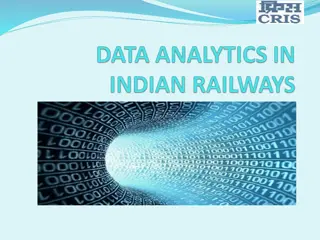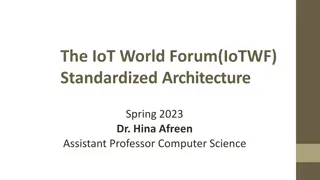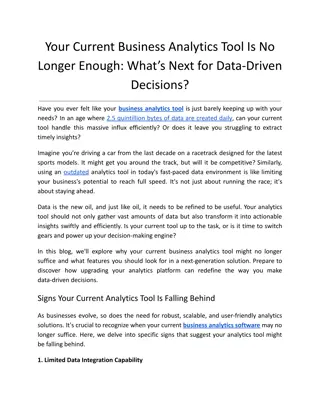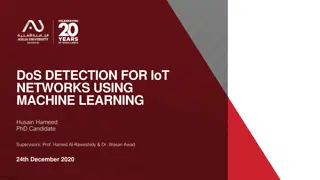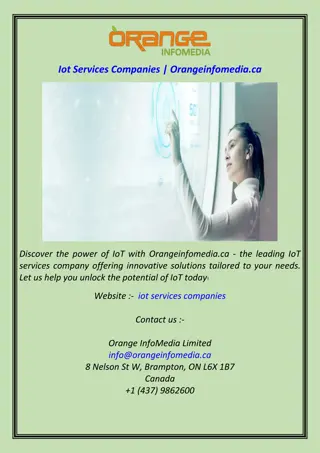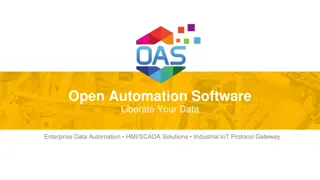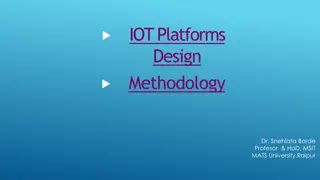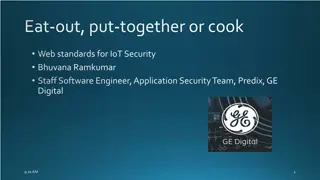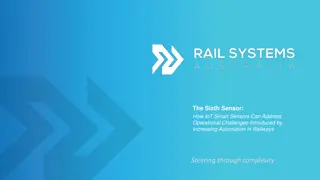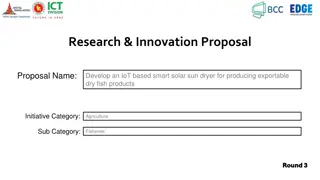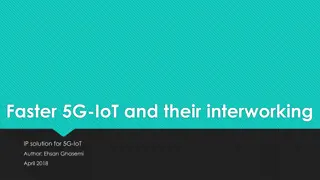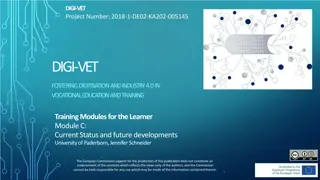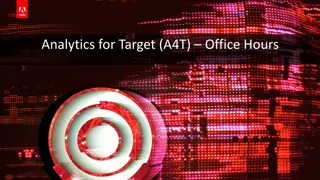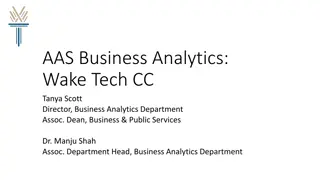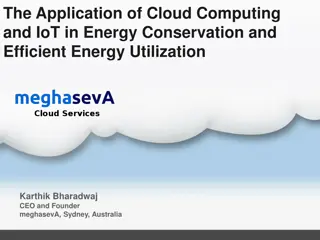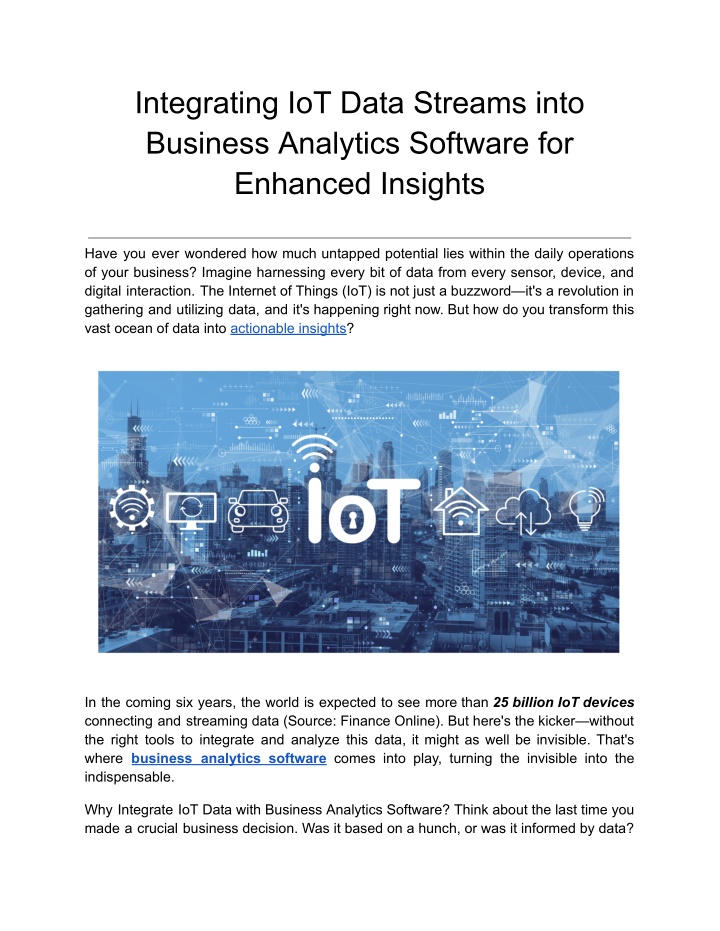
Integrating IoT Data Streams into Business Analytics Software for Enhanced Insights
Are you prepared to elevate raw data to become your ultimate strategic advantage? Immerse yourself in the realm of IoT integration through our newest blog, revealing how effortlessly merging IoT data streams with business analytics software can trans
Download Presentation

Please find below an Image/Link to download the presentation.
The content on the website is provided AS IS for your information and personal use only. It may not be sold, licensed, or shared on other websites without obtaining consent from the author. If you encounter any issues during the download, it is possible that the publisher has removed the file from their server.
You are allowed to download the files provided on this website for personal or commercial use, subject to the condition that they are used lawfully. All files are the property of their respective owners.
The content on the website is provided AS IS for your information and personal use only. It may not be sold, licensed, or shared on other websites without obtaining consent from the author.
E N D
Presentation Transcript
Integrating IoT Data Streams into Business Analytics Software for Enhanced Insights Have you ever wondered how much untapped potential lies within the daily operations of your business? Imagine harnessing every bit of data from every sensor, device, and digital interaction. The Internet of Things (IoT) is not just a buzzword it's a revolution in gathering and utilizing data, and it's happening right now. But how do you transform this vast ocean of data into actionable insights? In the coming six years, the world is expected to see more than 25 billion IoT devices connecting and streaming data (Source: Finance Online). But here's the kicker without the right tools to integrate and analyze this data, it might as well be invisible. That's where business analytics software comes into play, turning the invisible into the indispensable. Why Integrate IoT Data with Business Analytics Software? Think about the last time you made a crucial business decision. Was it based on a hunch, or was it informed by data?
Integrating IoT data into your business analytics dashboard doesn't just add volume to your data it transforms your approach from reactive to proactive, from guesswork to precision. Are You Ready to Dive Deep into Data-Driven Decision Making? Join us as we explore how the seamless integration of IoT data streams into business analytics software can enhance your insights and propel your business forward. Whether you're a data analyst crunching numbers, a business leader strategizing for the next quarter, or a BI professional looking to elevate your analytics game, this journey is for you. Let s unlock the full potential of your IoT investments and turn data into your most valuable asset. Key Technologies Facilitating IoT Data Integration APIs (Application Programming Interfaces): APIs are the linchpins in the integration of IoT data with business analytics software. They facilitate seamless communication between disparate intervention. By using APIs, businesses can ensure that data collected from various IoT devices is systematically ingested into business analytics platforms. This not only streamlines workflows but also enhances data reliability and timeliness, which are crucial for effective BI analytics. Middleware Solutions: Middleware acts as the critical intermediary that helps translate and route data from IoT devices to analytical software. This technology standardizes data formats, protocols, and communications, making it easier for business analytics tools to process and analyze data from varied sources. Middleware solutions can handle large volumes of data, thereby supporting the scalability requirements of extensive IoT frameworks. They also play a crucial role in data transformation, ensuring that the incoming IoT data is in the optimal format for analysis, which reinforces the importance of business analytics in decision-making processes. systems and devices without manual The Role of Cloud Computing in IoT Data Management Scalability and Flexibility: Cloud computing provides the scalability needed to manage the vast amounts of data generated by IoT devices. As IoT deployments grow, cloud platforms can dynamically adjust resources to handle increased data loads without compromising performance. This elasticity is vital for businesses that experience variable data inflow, ensuring that their business analytics dashboard remains robust and responsive.
Data repositories where IoT data can be aggregated, processed, and stored. This centralization ensures that data from comprehensive analysis on a unified business analytics dashboard. Furthermore, cloud computing enables real-time data access and analysis, which is paramount for industries requiring instantaneous insights to make critical decisions. Integration and Accessibility: Cloud platforms offer centralized multiple sources is available for The Impact of Edge Computing on IoT Integration Real-time Data Processing: Edge computing allows data processing to occur directly at or near the source of data generation (i.e., IoT devices). This proximity minimizes latency, facilitating faster decision-making which is integrated into BI analytics tools. Real-time processing is essential for scenarios where even a slight delay can result in significant opportunities. Bandwidth Optimization: By processing data locally, edge computing reduces the amount of data that needs to be sent to central servers or cloud systems. This not only conserves bandwidth but also reduces transmission costs and alleviates network congestion. For businesses, this means enhanced efficiency and reduced operational costs, highlighting the importance of business analytics in optimizing resource allocation. operational disruptions or missed Step-by-Step Guide to Integration Step 1: Evaluate Your Current Infrastructure Begin by assessing your existing IT infrastructure to determine if it can handle the scale and complexity of IoT data. This involves evaluating your network capabilities, data storage solutions, and computing power. You should also pinpoint the various IoT devices and sensors within your organization. Understand the type of data each device generates and its relevance to your business analytics objectives. Infrastructure Optimization: Beyond just assessing, consider ways to optimize your existing infrastructure. Implement edge computing solutions to process data locally on IoT devices, reducing latency and bandwidth usage. This preparation enhances your infrastructure s ability to handle real-time data, crucial for dynamic BI analytics environments. Integration Capacity Planning: Use predictive analytics to forecast future infrastructure needs based on expected growth in IoT data. This proactive
approach ensures scalability and responsiveness, keeping your systems agile and efficient. Step 2: Set Clear Integration Goals Clarify what you aim to achieve with your IoT integration. Whether it's improving operational efficiency, enhancing customer maintenance, setting clear goals will dictate the integration process. experiences, or boosting predictive SMART criteria Specific, Measurable, Achievable, Relevant, and Time-bound. This precision helps in tracking progress and justifying ROI to stakeholders. Feedback Loop Creation: Establish continuous feedback loops with end-users and technical teams to refine these goals based on real-world usage and challenges. This adaptive strategy keeps your projects aligned with business needs and technological advancements. Goals: Specify your integration goals using the SMART This alignment is also crucial so that you can justify investments and measure the impact of your IoT initiatives on your business analytics dashboard. Step 3: Choose the Right Business Analytics Software Select a business analytics software that can seamlessly integrate with IoT data streams. The software should be capable of handling large volumes of data in real-time and have robust data processing capabilities. Feature-Specific Evaluation: Dive deeper into specific features that support IoT integrations, such as real-time data analytics, machine learning capabilities for predictive analytics, and customizable APIs for unique business needs. Vendor Collaboration: Engage with software vendors to discuss potential customizations and support services. Establishing a strong vendor relationship can lead to tailored solutions that fit precisely with your organizational needs, enhancing the importance of business analytics. Customization and Scalability: Opt for software that offers customization to meet your specific business needs and can scale as your IoT deployment grows. The importance of business analytics software lies in its ability to adapt and evolve with your business demands. Step 4: Develop a Data Integration Plan Map out how data flows from IoT devices to your analytics system. This includes identifying data endpoints, storage solutions, and any intermediary services like APIs or middleware.
Advanced Data Routing: Implement sophisticated data routing protocols that intelligently direct IoT data streams to appropriate analytics tools based on data type, source, and intended use. This ensures efficient data handling and quicker insights. Compliance and Security Frameworks: Develop comprehensive security frameworks that comply with international data protection regulations like GDPR for European data and CCPA for Californian data. This will safeguard your data flows and build trust with your stakeholders. In short, developing a data governance model that defines who has access to the data, how it is used, and how it is protected is more than important, as it is crucial for maintaining data integrity and security. Step 5: Implement Data Processing Mechanisms Given the real-time nature of IoT data, implement processing mechanisms that can analyze data as it comes in. This is essential for applications that require immediate insights, such as fault detection in manufacturing processes. Data Enrichment: Enhance the value of your IoT data by integrating it with other business data sources. This can provide a more comprehensive view of your business analytics dashboard, deepening the insights into your operations. Hybrid Processing Models: Consider a hybrid approach that combines batch processing for historical data analysis with real-time processing for immediate insights. This dual approach maximizes the utility of your data across different business scenarios. Enhanced Data Enrichment Techniques: Utilize advanced AI models to enrich IoT data with predictive insights and anomaly detection. This can transform raw data into strategic information, making your business analytics dashboard a powerhouse of decision-making support. Step 6: Visualization and Utilization Integrate IoT data into your business analytics dashboard and customize your dashboard to display key metrics that are aligned with your integration goals. It is important to conduct training sessions for your team to ensure they understand how to use the new tools and data effectively. Adoption is critical to realizing the full potential of your BI analytics enhancements. Interactive Dashboards: Design interactive dashboards that allow users to drill down into specific IoT data points. Enable customized views based on user roles and preferences, making the dashboard more relevant and actionable for different stakeholders.
Decision Automation: Integrate automation tools that initiate actions based on specific dashboard insights, such as adjusting supply chain parameters in real-time or alerting maintenance teams about potential equipment failures. This automation enhances the impact of your BI analytics by translating insights into immediate actions. Step 7: Continuously Monitor and Optimize Regularly monitor the performance of your IoT integration to ensure it meets your set objectives. This includes tracking the speed, accuracy, and reliability of your data insights. AI-Driven Optimization: Employ AI algorithms to continually analyze the integration s performance and suggest unforeseen inefficiencies and opportunities for enhancement in real-time. Sustainability Practices: Monitor the environmental impact of your IoT integrations and aim for sustainable transmission distances and optimizing data storage solutions. This not only supports corporate social responsibility but also improves system efficiency. optimizations. This can identify practices, such as reducing data Know that IoT and business analytics are dynamic fields, therefore, you ought to continuously seek ways to improve data integration and analysis based on feedback and new technologies.
Conclusion Elevating Insights, Empowering Decisions As we conclude our journey through the integration of IoT data into business analytics software, it's evident that this technology is not just about collecting vast amounts of data it s about transforming that data into actionable insights that drive smarter, faster business decisions. This transformative power helps businesses not only stay competitive but also become leaders in their fields. Grow s advanced analytics platform exemplifies how seamlessly IoT data can be integrated, analyzed, and turned into strategic assets. By harnessing the capabilities of Grow, companies gain the clarity and precision needed to navigate complex markets and innovate continuously. Take Action and Transform Your Data Strategy Why wait to tap into the full potential of your IoT data? Start with Grow s 14-day free trial and experience how intuitive and impactful a well-integrated business analytics dashboard can be. See for yourself why countless businesses have shared positive feedback on "Grow.com Reviews & Product Details G2," praising the depth and usability of insights provided by Grow. This is your opportunity to step ahead and make data your most trusted ally in decision-making. With Grow, bridge the gap between data collection and business intelligence, and turn your IoT data streams into a fountain of actionable insights. Discover the power of enhanced insights with Grow where your data becomes your strategic advantage. Start your free trial today and join the revolution in business analytics. Original Source: https://bit.ly/3ABp3nY

